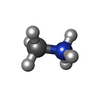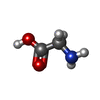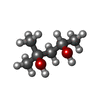[English] 日本語
 Yorodumi
Yorodumi- PDB-4ro2: Crystal Structure of CNG mimicking NaK-ETPP mutant cocrystallized... -
+ Open data
Open data
- Basic information
Basic information
| Entry | Database: PDB / ID: 4ro2 | ||||||
|---|---|---|---|---|---|---|---|
| Title | Crystal Structure of CNG mimicking NaK-ETPP mutant cocrystallized with Methylammonium | ||||||
 Components Components | Potassium channel protein | ||||||
 Keywords Keywords | TRANSPORT PROTEIN / Alpha helical membrane protein / ion channel | ||||||
| Function / homology |  Function and homology information Function and homology informationpotassium channel activity / metal ion binding / identical protein binding / membrane Similarity search - Function | ||||||
| Biological species |  | ||||||
| Method |  X-RAY DIFFRACTION / X-RAY DIFFRACTION /  SYNCHROTRON / SYNCHROTRON /  MOLECULAR REPLACEMENT / Resolution: 2.7 Å MOLECULAR REPLACEMENT / Resolution: 2.7 Å | ||||||
 Authors Authors | De March, M. / Napolitano, L.M.R. / Onesti, S. | ||||||
 Citation Citation |  Journal: Proc.Natl.Acad.Sci.USA / Year: 2015 Journal: Proc.Natl.Acad.Sci.USA / Year: 2015Title: A structural, functional, and computational analysis suggests pore flexibility as the base for the poor selectivity of CNG channels. Authors: Napolitano, L.M. / Bisha, I. / De March, M. / Marchesi, A. / Arcangeletti, M. / Demitri, N. / Mazzolini, M. / Rodriguez, A. / Magistrato, A. / Onesti, S. / Laio, A. / Torre, V. | ||||||
| History |
|
- Structure visualization
Structure visualization
| Structure viewer | Molecule:  Molmil Molmil Jmol/JSmol Jmol/JSmol |
|---|
- Downloads & links
Downloads & links
- Download
Download
| PDBx/mmCIF format |  4ro2.cif.gz 4ro2.cif.gz | 81.4 KB | Display |  PDBx/mmCIF format PDBx/mmCIF format |
|---|---|---|---|---|
| PDB format |  pdb4ro2.ent.gz pdb4ro2.ent.gz | 62.1 KB | Display |  PDB format PDB format |
| PDBx/mmJSON format |  4ro2.json.gz 4ro2.json.gz | Tree view |  PDBx/mmJSON format PDBx/mmJSON format | |
| Others |  Other downloads Other downloads |
-Validation report
| Summary document |  4ro2_validation.pdf.gz 4ro2_validation.pdf.gz | 502.7 KB | Display |  wwPDB validaton report wwPDB validaton report |
|---|---|---|---|---|
| Full document |  4ro2_full_validation.pdf.gz 4ro2_full_validation.pdf.gz | 512.5 KB | Display | |
| Data in XML |  4ro2_validation.xml.gz 4ro2_validation.xml.gz | 17.4 KB | Display | |
| Data in CIF |  4ro2_validation.cif.gz 4ro2_validation.cif.gz | 23.2 KB | Display | |
| Arichive directory |  https://data.pdbj.org/pub/pdb/validation_reports/ro/4ro2 https://data.pdbj.org/pub/pdb/validation_reports/ro/4ro2 ftp://data.pdbj.org/pub/pdb/validation_reports/ro/4ro2 ftp://data.pdbj.org/pub/pdb/validation_reports/ro/4ro2 | HTTPS FTP |
-Related structure data
| Related structure data |  4r50C  4r6zC 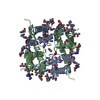 4r7cC  4r8cC  4raiC  3k0dS S: Starting model for refinement C: citing same article ( |
|---|---|
| Similar structure data |
- Links
Links
- Assembly
Assembly
| Deposited unit | 
| |||||||||||||||||||||||||||
|---|---|---|---|---|---|---|---|---|---|---|---|---|---|---|---|---|---|---|---|---|---|---|---|---|---|---|---|---|
| 1 | 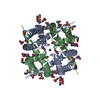
| |||||||||||||||||||||||||||
| 2 | 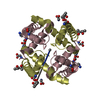
| |||||||||||||||||||||||||||
| Unit cell |
| |||||||||||||||||||||||||||
| Components on special symmetry positions |
| |||||||||||||||||||||||||||
| Details | The asymmetric unit is composed by two dimers. By 2-fold symmetry two tetramers are generated by each dimers. |
- Components
Components
| #1: Protein | Mass: 10626.555 Da / Num. of mol.: 4 / Fragment: residues 20-110 / Mutation: D66E, G67T, N68P, F69P Source method: isolated from a genetically manipulated source Source: (gene. exp.)   #2: Chemical | #3: Chemical | ChemComp-GLY / #4: Chemical | ChemComp-MPD / ( #5: Water | ChemComp-HOH / | |
|---|
-Experimental details
-Experiment
| Experiment | Method:  X-RAY DIFFRACTION / Number of used crystals: 4 X-RAY DIFFRACTION / Number of used crystals: 4 |
|---|
- Sample preparation
Sample preparation
| Crystal | Density Matthews: 2.45 Å3/Da / Density % sol: 49.82 % |
|---|---|
| Crystal grow | Method: vapor diffusion, hanging drop / pH: 6.5 Details: 100mM MES pH 6.5, 25mM Glycine, 40-44% MPD, 100mM MACl, VAPOR DIFFUSION, HANGING DROP |
-Data collection
| Diffraction | Mean temperature: 100 K | ||||||||||||||||||
|---|---|---|---|---|---|---|---|---|---|---|---|---|---|---|---|---|---|---|---|
| Diffraction source | Source:  SYNCHROTRON / Site: SYNCHROTRON / Site:  ELETTRA ELETTRA  / Beamline: 5.2R / Wavelength: 1.542 Å / Beamline: 5.2R / Wavelength: 1.542 Å | ||||||||||||||||||
| Detector | Type: DECTRIS PILATUS 2M / Detector: PIXEL / Date: Oct 12, 2014 | ||||||||||||||||||
| Radiation | Monochromator: Si111 / Protocol: SINGLE WAVELENGTH / Monochromatic (M) / Laue (L): M / Scattering type: x-ray | ||||||||||||||||||
| Radiation wavelength | Wavelength: 1.542 Å / Relative weight: 1 | ||||||||||||||||||
| Reflection | Resolution: 2.7→47.84 Å / Num. all: 11995 / Num. obs: 11995 / % possible obs: 100 % / Observed criterion σ(F): 1.7 / Observed criterion σ(I): 1.7 | ||||||||||||||||||
| Reflection shell |
|
- Processing
Processing
| Software |
| ||||||||||||||||||||
|---|---|---|---|---|---|---|---|---|---|---|---|---|---|---|---|---|---|---|---|---|---|
| Refinement | Method to determine structure:  MOLECULAR REPLACEMENT MOLECULAR REPLACEMENTStarting model: 3K0D Resolution: 2.7→45.52 Å / σ(F): 1.7 / Stereochemistry target values: Engh & Huber / Details: TWIN REFINEMENT with REFMAC5
| ||||||||||||||||||||
| Refinement step | Cycle: LAST / Resolution: 2.7→45.52 Å
| ||||||||||||||||||||
| Refine LS restraints |
|
 Movie
Movie Controller
Controller



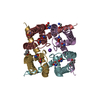









 PDBj
PDBj



